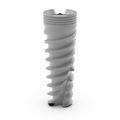What Defines Implant Success? A Broader Perspective
Dear colleagues and readers,
I’m Dr. Bernardo Grobeisen, and in my experience as both a clinician and lecturer, true success in implant therapy goes far beyond the surgical outcome.
Recently, my university students and I conducted a review of the key criteria used to evaluate the success of dental implants. One thing that stood out to me was how much weight is placed on the state of osseointegration. Many of the articles we reviewed emphasized the relationship between the implant platform and the marginal bone level, often giving little attention to other important factors.
Let me be clear — osseointegration is critical. But I believe that other factors are equally vital. From a restorative standpoint, the most important goal is to ensure that the implant is prosthetically restorable. After all, what good is a well-integrated implant if it can’t support a functional and aesthetic restoration?

Patients don't come to us for screws — they come for teeth. An implant that is poorly planned prosthetically is, in many cases, not restorable — and therefore, not useful at all.

We must consider a wide range of clinical and restorative factors when evaluating implant success. Among them:
- Three-dimensional positioning of the implant
- Connection orientation and prosthetic screw emergence
- Available restorative space
- Emergence profile
- Contact points and absence of black triangles
- Condition of the gingival tissues
- Pink and white esthetics
- Type of restoration and abutment selection
- Periodontal health — of both the implant and adjacent teeth

- Occlusion and long-term maintenance planning
- Choice of restorative materials
- Patient satisfaction
These factors are not specific to the implant itself, but they are essential to successful implant therapy — which must always be approached from a multidisciplinary, prosthetically driven perspective.
Since Dr. Brånemark’s time, the surgical aspect of implant therapy has often taken center stage. Yet, it is the restorative phase that truly gives purpose to implants — helping patients regain full function and confidence.
In my opinion, the foundation of success lies in proper diagnosis. We must evaluate the patient thoroughly and holistically — not only their oral health, but also their systemic health and how the two are connected. A precise understanding of the patient’s periodontal, occlusal, biological, functional, and aesthetic status is essential to restoring true oral health. Negligence or lack of expertise can lead to catastrophic complications that are far more difficult to resolve.
What are your thoughts on defining implant success? Share your clinical experiences and unique perspectives in the comments below. I look forward to a vibrant discussion.
Warm regards,














0 comments